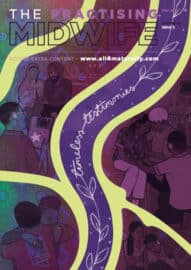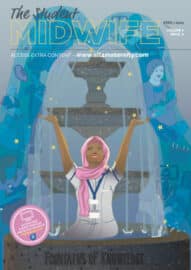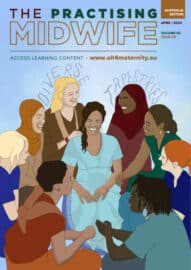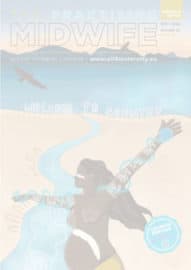Birth (and midwives) in the Media
By Laura Godfrey Issacs – Midwife, Artist and Activist

Birth of My Daughter, 2005 by Ana Alvarez-Errecalde
August 2018
In August 2017, myself and many others were caught up in a storm of media ‘stories’ and debates around birth. These were swirling around the misapprehension that the Royal College of Midwives (RCM) had dropped the use of the term ‘normal birth’ (Guardian, 2017) – despite the fact that normal birth is universally used to define a midwives scope of practice (ICM, 2005, Lancet, 2016). This has made it almost a ‘dirty’ word, with euphemisms arising such as physiological birth, optimal outcomes and positive experiences, struggling to fill the gap.
Even though the debate about ‘normal birth’ seems to have died down, this has not stopped the contested site of birth remaining a topic subjected to much media incitement. Witness the reporting of a RCM Position Statement around Infant feeding (RCM, 2018) – where it was suggested women who used formula milk to feed their babies should be respected – something that was in the last RCM statement, and widely understood and acted upon by midwives, but was blown up by tabloid newspapers. Here the accusation was that midwives and those who support breastfeeding are militantly against BMS (breast milk substitutes) with familiar tropes being rolled out – such as the ‘breastapo’ being used to conjure the idea of coercive breastfeeding supporters pressurising women and putting babies at risk. This once again triggered a furious debate on social media

It is evident that many women feel angry, are let down and not receiving good maternity care or breastfeeding support. This needs to be heard by all health care professionals working in maternity, and needs major structural change to alter. However, it is also clear that media ‘stories’ tend to obfuscate, stoke division and increase polarisation whilst avoiding the complexity of the issues – and tend to demonise midwives.
Other recent media furores this Summer include Harry Kane, the footballer, being criticised for saying he was ‘so proud’ of his wife, who gave birth without pain relief. This triggered the #soproud hashtag generated by Milli Hill of the Positive Birth
Movement (2018). This saw an incredible outpouring of women exclaiming they were #soproud of all types of birth (Positive Birth Movement, 2018), as well as midwives proud of women, and their colleagues. A beautiful counter to an otherwise negative, polarised and shaming response.
Then in Australia, the press printed a statement by an obstetrician who, whilst criticising various CPD courses for midwives that used complementary therapies, used the most inflammatory language – describing midwives who use ‘dark arts’. The media immediately jumped on this ‘birth war’ and went overboard with reports and cartoons vilifying midwifery care.

With this regular playing out of debates around birth and infant feeding in the media I thought it would be timely to repost this blog, exactly one year on, Even though it concentrates on the normal birth debacle in the media from 2017, it attempts to unpack some of the complexity and familiar media narratives which we see once again this August.
August 2017
We will all experience a ´media-informed´ birth wrote Fleming et al in 2014, with information that is ´fragmented, weakly linked and poorly referenced´ – how pertinent this seems of the journalism displayed in major UK newspapers in August 2017, and how it highlights the responsibility journalists have to portray birth in a balanced way, as most women will not witness birth before they are in labour.
In 2016, I undertook an extensive literature search examining birth in the media since the 1980s. I identified the same themes. They are very much in evidence as you trawl through the articles. These themes have been seen to reinforce certain dominant ideologies and narratives of birth, as well as around motherhood and gender.

One Born Every Minute
For example, the first and perhaps most pervasive idea is that birth as an event is predominantly about ´fear, speed, pain and danger´ explored by Elson (2009) in her study ´Mass Media vs the real thing´: here we see birth depicted in countless films and TV shows as an emergency event with ´women as powerless, physicians in control and technology as the saving grace for women´s imperfect bodies´ as observed by Morris & McInerney (2010) in their analysis of reality TV shows in the US. This idea has been perpetuated, ironically by the contention in recent articles that midwives’ pursuit of ´normal birth´ (something that is written into their international definition of scope of practice by the International Confederation of Midwives, 2005) is the cause of stillbirths in the UK (which are higher in relation to some other European countries). The contention is astonishing when the evidence, such as the Birthplace Cohort Study (Brocklehurst et al 2011) concluded that births in midwifery-led settings in the UK are safe, including those at home and midwifery-led units (which are attended by midwives only) with fewer unnecessary interventions than in obstetric settings.
Secondly, as with this current rash of articles, we see an emphasis on medicalised birth as the norm, satirised by Monty Python in ´The Miracle of Birth´ way back in the 1980´s with their parody of a CS and the machine that goes ´ping´: this as Sheila Kitzinger (2001), the famous birth anthropologist, suggested, normalises the medical narrative and encourages women to ´submit´ to the potential scenario. So if women only see medicalised birth, it tends to suggest that anything other than this is outside of the norm, and only practised by women who are hostile to the status quo, and by extension builds mistrust of midwives who seem to be ´peddling´ this kind of birth choice.

Amy Digam, 2017 Maternal Journal
Thirdly, we see women´s autonomy and agency in birth diminished, dismissed or ridiculed, with media texts tending to promote dominant social constructs around femininity with ´the good woman´ and by extension the ´good obstetric patient´, ´identified by Williams & Fahy (2014) being highly valued. The implication, therefore is that women should ´do as they are told´ within the medical paradigm, and not question or have their own choices taken into consideration. In addition, partners (nearly always men) are often cast as the hapless and comedic figure, who similarly should remain unquestioning and compliant.
Finally we come to the depiction of midwifery – often absent from the representations of birth, unless as an historical, harmless, bicycle-riding nostalgic figure such as in ´Call the Midwife´ or as we have seen this week as the bad guy´, in distinct contrast to the heroic medical figure. In an analysis of newspaper reporting of adverse birth outcomes Professor Bick (2010) describes how ‘experts´ are used to analyse negative outcomes in a highly selective way, are rarely midwives and seldom proffer a balanced view. Furthermore, vilification of midwives and their singling out selectively from reports is common-place, as this headline from the Daily Mail (Borland, 2011) exposes: ‘If you don´t hurry up I will cut you- what one woman was told at NHS Trust where five died´.
Therefore, the depiction of birth as a dangerous event which should not be left in the hands of midwives, and the vilification of midwives for their support of ´normal birth´ could be seen to be part of a long-standing media narrative, which seems to have reached a height recently. The question now is why, and why now?

Amy Dignam, 2017 Maternal Journal
Birth does not fit easily into the medical paradigm, it is not a ´procedure´, there is no ´cure´ and women are generally not sick – comparisons with dentistry or colonoscopy therefore (suggested this week by some columnists) is not useful. We do not even know yet what triggers labour – but what we do know is that birth is a process that involves a subtle and complex interaction between hormones from the baby and the mother, which start it, and it is a physiological process vulnerable to interruption, be that from fear (adrenaline) or medical interventions. Midwives who are ´with woman´ and go through the whole experience with women are acutely aware of the fragility of the process, which can be heavily influenced by the environment, birth setting and people involved – and the dangers of interference with this process.
Birth is also not just a process but a major life event for the woman, the baby, the family and by extension has implications for the whole of society – how we are born has a major effect on our mental and physical health, due to the cocktail of hormones, interactions and experiences we have at the time, and how we give birth as women, has major implications on our health, subsequent pregnancies, and may effect how we mother and parent. Midwives have a public health role and therefore are aware of the long term implications of certain birth practices, and have a responsibility towards the health and wellbeing of the whole family throughout the birth continuum -therefore the outcomes of birth are far reaching, with safety (physical and psychological) a complex consideration.
Birth is also a place of contested ideologies and ownership – historically a space controlled by women, and relatively recently a place shared with a medical profession and politicians. And, at some times and in some places medical interests and politics have tried to squeeze out women´s traditional place and knowledge of birth. Turf wars continue to run and the polarisation of birth can be a cause of conflict between professionals, women and in society – over who should really control birth; the doctor, the midwife, politicians or the woman – but of course the best scenario is when all those actors work together to facilitate a woman´s birth, where she feels in control, respected and has the best outcome possible, whatever her preferences or needs. This history and these questions point to wider societal struggles over women´s sexual, reproductive and bodily integrity and control – and is a symptom of a dominant patriarchal culture within which birth is framed.

Hananh Lamdin with original photo by Lara Downie, from Maternal Journal 2017
Midwives are caught harshly in these debates as they traditionally represent women´s power and knowledge in birth, distinct from medical institutions (despite their professionalisation). They are generally women themselves and are therefore subject to a partriarchal system of control (their response to some media reporting recently
called ´hysterical´ by a columinst – an insult that implies they cannot think rationally as their wombs are moving around), or identified as ´cultish´ and ´radicalised´. And, we all are subject and bound by a pervasive move towards media opinion rather than facts in our post-truth era, which results in the discrediting of research and
experts in any field, compared with those with media or political power.
What can we do in the face of this onslaught of media ´stories´ and opinion, for the sake of the midwifery profession and the women we care for, so that a more balanced view of birth and midwives is promoted. What we can do is unpack the dynamic, look at our own place within in, and become aware of some of the misogynistic constructs in the media around how a woman gives birth or mothers her children. We can speak up, and not be silenced. We can carry on with our practice and treat women as individuals, providing them with the best evidence around birth, and keep asserting the research, which is that midwifery is a safe practice, that is highly regulated and controlled, and that there is no guidance that pushes for normal birth ‘at any cost´. We can work with our obstetric colleagues and other medical professionals in the maternity team by putting women at the centre of care, and ultimately we need to stress that, as stated by the Lancet Series on Midwifery, the WHO and many other global health and development organisations, the world needs more midwives not less.
References
Bick D (2010) Media portrayal of birth and the consequences of misinformation. Midwifery 26 147-148
Borland S (2011) http://www.dailymail.co.uk/health/article-2054171/NHS-maternity-care-Midwife-tells-mother-dont-hurry-Ill-cut-you.html
Brockelhurst et al (2011) Birthplace Cohort Study https://www.npeu.ox.ac.uk/birthplace
Elson V & Conway M A (2009) Laboring Under an Illusion: Mass Media Childbirth vs. the Real Thing (DVD). Available online at: http://www.birthmedia.com/
Fed is Best (2018) https://fedisbest.org
Fleming S. E, Vandermause.R, Shaw.M (2014). First-time mothers preparing for birthing in an electronic world: internet and mobile phone technology. Journal of Reproductive and Infant Psychology, 2014 Vol. 32, No. 3, 240–253
Guardian (2017) https://www.theguardian.com/society/2017/aug/12/midwives-to-stop-using-term-normal-birth
ICM (2005) International Definition of the Midwife http://internationalmidwives.org/who-we-are/policy-and-practice/icm-international-definition-of-the-midwife/
Lancet (2014) Lancet Series on Midwifery http://www.thelancet.com/series/midwifery
Kitzinger S & Kitzinger J (2001) Sheila Kitzinger’s and Jenny Kitzinger’s Letter from Europe: Childbirth and Breastfeeding in the British Media. Birth – issues in perinatal care. Available online at: https://onlinelibrary.wiley.com/toc/1523536x/2001/28/1
Monty Python (1993) Meaning of Life. Available online at: https://www.youtube.com/watch?v=arCITMfxvEc
Morris T & McInerney K (2010) Media Representations of Pregnancy and Childbirth: An Analysis of Reality Television Programs in the United States. Birth. Vol.37. No.2 p134-140
RCM Position Statement on Infant Feeding (2018) https://www.rcm.org.uk/sites/default/files/Infant%20Feeding.pdf
Williams.G. & Fahy.K (2004) Whose interests are served by the portrayal of childbearing women in popular magazines for women? Australian Midwifery Journal 17:1: 11-16







